ब्रॉयलर प्रबंधन: मुर्गी पालन विकास के लिए कुशल रणनीति
A Broiler is a bird of about 6-8 weeks of age of either sex (straight-run chicks) with an average body weight of 1.5 to 2.0 kg with a flexible breast bone cartilage, pliable and tender meat. It is a tender meat young chicken of either sex that grows from a hatch weight of 38-40 gm to a weight over around 1 Kg 700 gm in about 6 weeks’ time only.
Factors acting broiler quality and growth:
Various factors affecting the growth rate in the broilers include health, nutrition, temperature, water supply, vaccination, lightening, food supply, water supply, ventilation, stocking density.
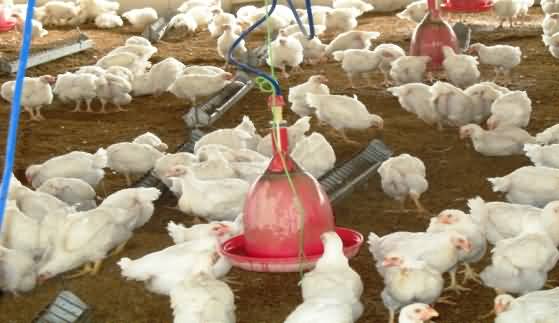
Housing system and rearing system in broilers:
Broilers can be housed on deep-litter, slatted or wire floor or cages. In case of broilers cage, slat and wire floor rearing of broilers are not as popular as litter floor rearing, due to problems like breast blisters, leg weakness and higher initial investment.
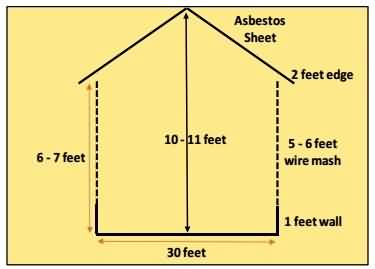
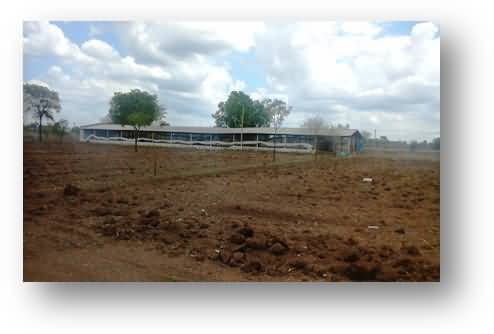
For selection of site for broiler farming one must first select a well-drained site that has plenty of natural air movement. The area has to be oriented on an east-west axis to reduce the effect of direct sunlight on the sidewalls during the hottest part of the day· Good ventilation should be available; to achieve this width of the farm should be 25ft but in any condition do not exceed 30ft. While making shed local climate, cost effectiveness, durability &provision of comfortable environment in all the seasons should be considered.
Durability of farm is very important especially in coastal areas where cyclones fall on land and plains of north India where frequent dust storms are encountered in summer season. Farm damaged in storms could wipe out your total profitability of a year in one go.
Sufficient overhang to the roof is necessary to provide shade and prevent entry of direct rains into the house. This overhang should be 0.6m long. Roofing material should provide good insulation from heat and should not allow rain water to enter the house.
Houses constructed underneath the shadow of trees get better cooling effect. In open houses sufficient height of the roof is to be maintained to facilitate ample air exchange and to maintain optimum temperature conditions to the birds.
Height in the middle of the farm should be 9 to 11ft and on sides should be 6 to 7ft. Lighting should be fitted with a view to provide an even distribution of light throughout the house.
The farm shown in above picture is natural or open house: In Indian conditions, because of the climate we do have poultry houses with both sides open. Temperature is controlled with the help of curtains. Depending upon the season one has to operate the curtains or use heaters or brooders to increase the temperature. In summer season, we recommend fans, sprinklers, foggers where the temperature are higher.
One can either use low pressure fogger nozzles or high -pressure fogger nozzles for those houses located in hot and dry climate. With the help of expert, one may choose the suitable fogging system. It is also suggested to have roof insulation (thatch). Where there is a water scarcity and high temperature, on wind side mesh, one can use wet Gunny cloth curtain to lower down the temperature.
Correct stocking density is essential to the success of a broiler production system by ensuring adequate room for optimal performance; in warmer climates a stocking density of 30 kg/m2 is closer to ideal. India comes under warmer climate as 8 out of 12 months are warm.
The partitions are provided in farms to have pens which can accommodate 600 to 700 birds. There is a thumb rule for housing management in broilers first 10 days; 3chicks in 1sqft, second 10 days 2chicks in 1sqft and 3rd 10 days; 1 bird per sqft and after 30 days 1 bird per 1.2sqft.

Drinker system in broiler management:
For optimal broiler performance, it is recommended to use a closed drinker system. Water contamination in a closed nipple drinker system is not as likely as with open drinker systems. Wasting water is also less of a problem. In addition, closed systems offer the advantage of not requiring the daily cleaning necessary with open drinking systems. However, it is essential to regularly monitor and test flow rates as more than a visual assessment is required to determine whether all nipples are operational.
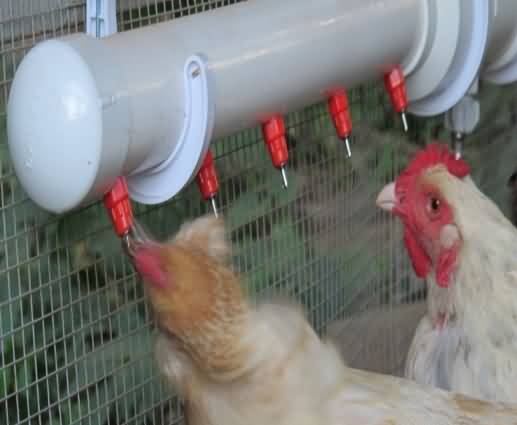
Bell or Cup Drinkers (Open Systems) –
While there is a cost advantage of installing an open drinker system, but problems associated with open drinker system is litter quality, condemnations and water hygiene are more prevalent. Water purity with open systems is difficult to maintain as birds will introduce contaminants into the reservoirs resulting in the need for daily cleaning.
This is not only labor-intensive but also wastes water. Bell drinkers should provide at least 0.6cm (0.24 in.) per bird of drinking space.1 drinker per 70 birds is required.
Nipple Systems (Closed systems)-
High flow nipple drinkers provide a drop of water and have a cup to catch any excess water. Generally, 10 - 12 birds per nipple are recommended. Low flow rate nipple drinkers: Do not have cups, Generally, 10 birds per nipple are recommended. Birds should not have to travel more than 8 ft. to find water. Nipples should be placed at a maximum of 35 cm (14 in.) centres.
Providing clean, cool and fresh water with adequate flow rate is fundamental to good poultry production. Without adequate water intake, feed consumption will decline and bird performance will be compromised. Both closed and open watering systems are commonly used. From day old to first 10 days of age, a minimum of 16 - 20 chick(mini) drinkers should be provided per 1000 chicks.
As the broilers grow older chick drinkers are to be replaced with Bell type drinkers at the rate of one drinker per 70 birds. These drinkers should be placed evenly throughout the house so that birds need not walk more than 8 feet to drink water. Drinkers should be checked for height on a daily basis. Height of the drinkers is such that the base is in level with the bird’s back.
Feeding system in Broiler Management:
Regardless of which type of feeding system issued, feeding space is absolutely critical. If feeder space is insufficient, growth rates will be reduced and uniformity will severely compromise 50-70 adult birds per 33 cm (12 in.) diameter pan are recommended. Supplemental feeders (additional chick feeders) should be provided for the first 7 to 10 days in the form of paper, trays or lids.
Feeding tray for poultry chicks increases wastage. I recommend that trays are better alternative, when chicks arrived in farm provide feed on paper for 6 to 8 hours and then switch to trays. It is of utmost importance that the additional feeders should not run empty as this will reduce yolk sac absorption. It means that feed should make available as soon as chicks arrived in the farm.
Early feeding increases yolk utilization and reduces chances of yolk problems. Trays should be provided at a rate of one per 100 chicks. If using paper, the feed area should be a minimum of 25% of the brooding area. 50-65 grams of feed per chick on the paper is recommended.
In early 2or 3 days paper could be used but it should be avoided. Additional feeders should be refreshed (refilled) three times daily, until all the chicks are able to gain access to the main feeding system. This generally occurs at the end of the first week.
The four key components of a broiler house include Roofing material should have a reflective surface on the outside to help reduce the conduction of solar heat and should be well insulated. Heating systems should have ample heating capacity in accordance with the climate.
Ventilation systems should be designed to provide ample oxygen and to maintain optimum temperature and relative humidity conditions for the birds. Lighting should be oriented to provide an even distribution of light at the floor level.
Insulation:
Key to maximizing bird performance is the provision of a consistent house environment. Large fluctuations in house temperature will cause stress on the chick and affect feed consumption. Furthermore, these fluctuations will result in additional energy expenditure to maintain body temperature. This will help to conserve heating costs, reduce solar energy penetration and prevent condensation. The most important insulation requirements are in the roof.
A well-insulated roof will reduce solar heat penetrating the house on warm days, thus decreasing the heat load on the birds. In cold weather a well-insulated roof will reduce heat loss and energy consumption needed to maintain the correct environment for the chick during the brooding phase, the most important time in the development of the chick.
The roof should be insulated to a minimum R-value of 20-25 (climate dependent). Higher the R value better the insulation.
Ventilation:
The main purpose of minimum ventilation is to provide good air quality. It is important that the birds always have adequate oxygen, optimum relative humidity and minimum amounts of carbon dioxide (CO2), carbon monoxide (CO), ammonia (NH3) and dust.
Inadequate minimum ventilation and the resulting poor air quality in the poultry house can cause increased levels of NH3, CO2, moisture levels and an increase in production related syndromes such as ascites. Always evaluate NH3 levels at bird height.
The negative effects of NH3 include: foot pad burns, eye burns, breast blisters/skin irritations, decreased weights, poor uniformity, disease susceptibility and blindness.
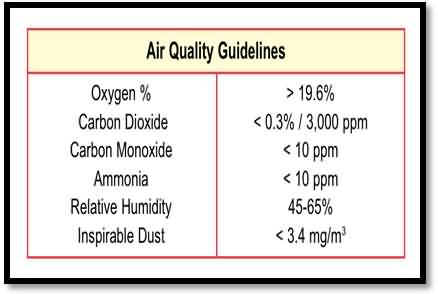
Litter Management:
Rarely given sufficient emphasis, litter management is another crucial aspect of environmental management. Correct litter management is fundamental to bird health, performance and final carcass quality which subsequently impacts the profit of both growers and integrators. Racking should be done every week · Avoid re -use of litter ·
If litter is seemed to be damp add lime powder to keep it dry. Important functions of litter include the ability: To absorb moisture, dilute excreta, thus minimizing bird to manure contact, provide an insulation from cold floor temperatures. A practical way to evaluate litter moisture is to pick up a handful and gently squeeze it.
The litter should slightly adhere to the hand and break down when dropped to the floor. If moisture is in excess it will stay compacted even when dropped. If litter is too dry it will not adhere to your hand when squeezed. Excessive litter moisture (>35%) may cause welfare and/or health challenges.
An increased incidence of breast blisters, skin burns, condemnations and downgrades may result. Litter with high moisture content may also contribute to elevated ammonia levels. The following are some key points to consider when re-using the litter: Down time between flocks should be at least 12 days to maintain good litter quality.
All wet caked litter to be removed during down time. In the case of a disease challenge, it is never recommended to re-use the litter. The availability and cost to replace old litter.
Preparation of poultry house: Shed should be thoroughly cleaned and disinfected before arrival of chicks. Fumigation with Potassium permanganate and formaldehyde (1:2) can be successfully used for disinfection of poultry house. This method produces a violent chemical reaction that generates considerable heat and releases formaldehyde gas.
Recommended dosage is 20 grams of Potassium permanganate is to be added to 40 ml of Formalin. Because of the violent chemical reaction, never use more than 1.2 liters of formalin in any one container.
The container should be sufficiently bigger, at least 3 times the volume of disinfectant to prevent the mixture from bubbling over. The container must be placed on concrete or metal surface and not on litter material. Potassium permanganate is to be added to formalin and not vice versa.
Brooding Management:
Chicks cannot regulate their own body temperature until they are around 12–14 days of age. Ideal body temperature must be attained by providing optimal environmental temperature. Preheating the house is vital as floor temperature at chick placement is as important as air temperature. Stabilize temperature and relative humidity for at least 24 hours prior to chick arrival.
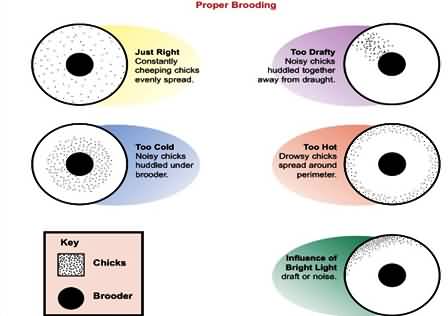
Rearing system:
All-in all-out system:
Under all-in all-out system, the farm will have only one batch of broilers, belonging to the same hatch at any time. Sufficient chicks will be purchased to accommodate the entire farm capacity, reared and marketed in a single lot.
This system is more hygienic, lesser sub-clinical infections and horizontal spreading of diseases and thereby lesser mortality rate, better growth rate and improved feed efficiency. However, this system is not suitable for large scale farming and needs higher fixed and working capital per bird.
Multiple batch system:
The multiple batch system consists of rearing of more than one batch of chicks at any time, with a batch interval of 1 to 4 weeks. Here, the farmer is buying day-old chicks and selling grown up broilers at weekly, fortnightly, once in three weeks or at monthly intervals. The chicks are reared for five to six weeks of age, or until they attain the desired body weight and sold for table.
The ideal system for India at present is having 5 to 6 batches of broilers at any time, with weekly interval between batches and “direct retail marketing”. Here, the birds will be marketed daily, from 40 to 54 days of age, based on their body weight, i.e. heavier birds will be sold earlier; giving a chance for weaker birds to have a compensatory growth.
Managemental practices:
The floor space, feeder space and waterer space depend on body weight at the time of marketing, housing systems, marketing age, ambient temperature, health condition of the birds. The nutritional management in broilers include pre starter diet for 0 to 10 days, starter diet for 11-21 days and finisher diet from 22 days to marketing.
The most commonly recommended lighting programme is 24 hours light during brooding period, Followed by 23 hours light and one hour darkness per day, until marketing. This one-hour darkness is to train the birds to acclimatize for darkness, in case of power failure, which may cause panic and trampling.
Always use birds’ behavior and effective temperature as the ultimate guide to determine the correct temperature for the birds. Chicks from smaller eggs (younger breeder flocks) require higher brooding temperatures because they produce less heat about 1 ºC for the first seven days.
Vaccination and common diseases in broilers:
The common diseases in broilers include VIRAL DISEASES (Ranikhet disease, Marek’s disease), BACTERIAL DISEASES (Salmonellisis, Colybacillosis), FUNGAL DISEASES (Brooder pneumonia / aspergillosis), HELMINTHIC DISEASES (Inappetance, Poor body growth, Ruffled feather, Diarrhoea), PROTOZOAN DISEASES (Coccidiosis).
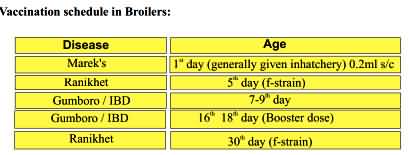
Bio-security is a practice designed to prevent the spread of disease onto your farm. Bio-security has three major components: isolation, traffic control, sanitation.
The objective of the broiler management is to achieve the required flock performance in terms of bird welfare, live weight, feed conversion, uniformity, and meat yield within economic constraints. For maximum performance to be attained, each stage must be assessed critically and improvements made wherever required. Broiler production is a sequential process, with ultimate performance being dependent on each step being completed successfully.
References:
BROILER MANAGEMENT HANDBOOK: arbor acres
Vantress.com: broiler management guide
Broiler farming: govt. of Sikkim
Broiler management: by TNAU
Authors
Dr. Rishi Nanda*, Dr. lipika Sarma, Dr. Priyanka M. Kittur, Dr. Amit Kumar, Ankita Lohumi
Physiology & Climatology Division, ICAR-Indian Veterinary Research Institute, Izatnagar, Bareilly, 243122, Uttar Pradesh, India.
*email id:
